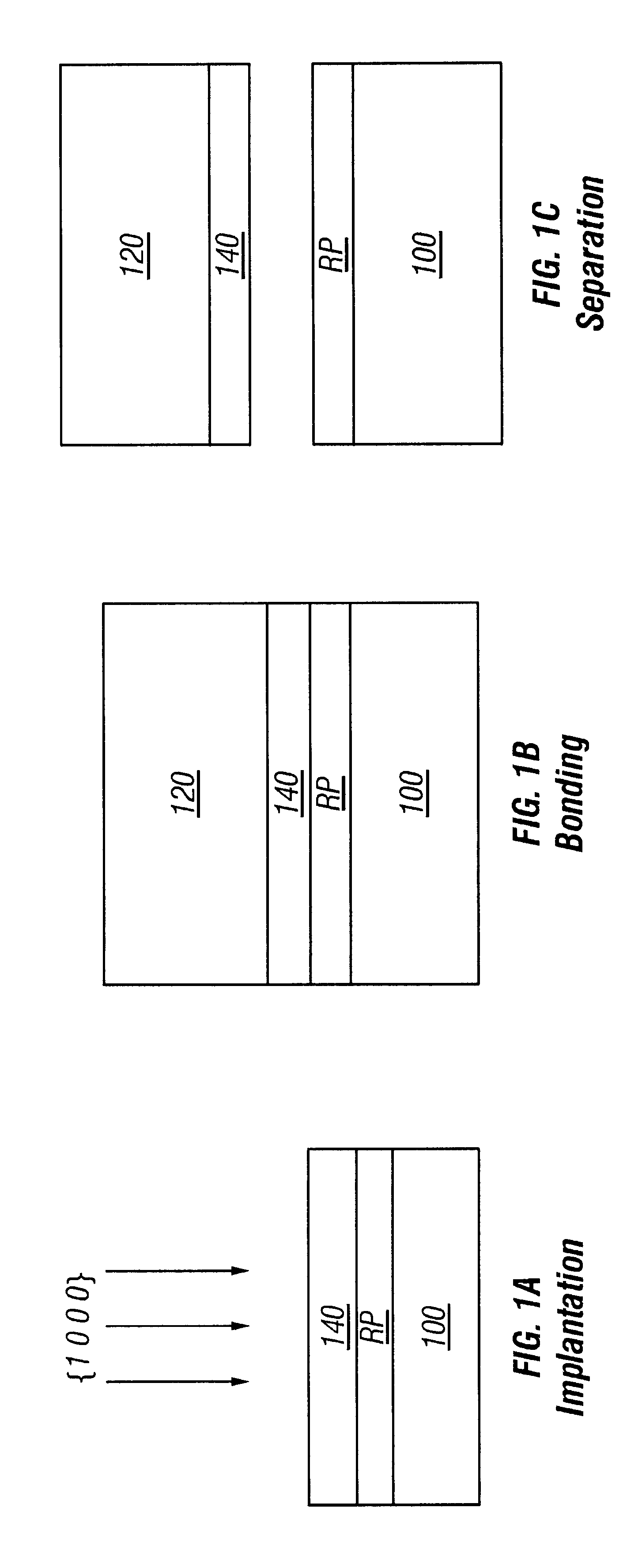Method for transfer of thin-film of silicon carbide via implantation and wafer bonding
a technology of silicon carbide and thin film, which is applied in the direction of semiconductor/solid-state device manufacturing, basic electric elements, electric apparatus, etc., can solve the problems of not being able to use electronic device applications, not being able to transfer thin films of sufficient quality for device applications, and deactivating or passively transferring carriers
- Summary
- Abstract
- Description
- Claims
- Application Information
AI Technical Summary
Problems solved by technology
Method used
Image
Examples
first embodiment
A first embodiment of the invention is based on the use of channeled light-ion implantation to effect the thin-film transfer process. This embodiment is depicted schematically in FIGS. 1A-1C.
FIG. 1A depicts light-ion implantation of a bulk SiC single-crystal 100 along the {1 0 0 0} direction. The light-ions can include hydrogen ions. A thin-film 140 is defined above a strained region R.sub.p. Substrate 100 may include an epitaxial silicon carbide film with controlled impurity doping. Thin-film 140 is defined above the strained region Rp, both of which are included in the silicon carbide crystal 100.
FIG. 1B illustrates the bulk SiC single-crystal 100 being bonded to a target wafer 120. To ensure good bonding, the single-crystal 100 and / or the target wafer 120 can be oxidized or deposited with a thin-film of silicon oxide. Any oxide coating on the single-crystal 100 should be applied after light-ion implantation to avoid scattering of the ions during channeling.
FIG. 1C depicts separat...
second embodiment
A second embodiment of the invention is based on high-temperature processing of the wafers. If the implantation is done at high-temperature (e.g. 600.degree. C.), a substantial reduction of the critical dose, as well as ion-induced damage occurs compared to room-temperature (e.g. 20.degree. C.) processing.
In the case of SiC, implantation at an elevated temperature of approximately 600.degree. C. reduces the critical dose by nearly a factor of 2, from 4.5.times.10.sup.16 cm.sup.-2 per square at room-temperature to 2.8.times.10.sup.16 cm.sup.-2 per square. The retained fraction of hydrogen in the sample implanted at 600.degree. C. is higher by about a factor of 2 than in room-temperature samples (after cycling 1200.degree. C.). This reduces the amount of hydrogen diffusing within the thin-film so that void formation is suppressed.
Of course the invention is not limited to SiC. Any crystal targets can be used. The crystal targets can be held at approximately 300.degree. C., approximatel...
third embodiment
A third embodiment of the invention is based on a combination of both the first embodiment and the second embodiment (i.e. channeled-ion implantation at elevated temperatures). This allows the use of a lower dose and thus less chance of producing lattice damage. In the case of a silicon carbide crystal, this combination approach further reduces the critical dose to approximately 2.5.times.10.sup.16 cm.sup.-2.
While not being limited to any particular performance indicator or diagnostic identifier, preferred embodiments of the invention can be identified one at a time by testing for the presence of a narrow region of strain (Rp). The test for the presence of narrow Rp can be carried out without undue experimentation by the use of a simple and conventional Rutherford backscattering experiment. Another way to seek embodiments having the attribute of a narrow region of strain is to test for the presence of smooth topography after thin-film transfer.
Practical Applications of the Invention...
PUM
 Login to View More
Login to View More Abstract
Description
Claims
Application Information
 Login to View More
Login to View More - R&D
- Intellectual Property
- Life Sciences
- Materials
- Tech Scout
- Unparalleled Data Quality
- Higher Quality Content
- 60% Fewer Hallucinations
Browse by: Latest US Patents, China's latest patents, Technical Efficacy Thesaurus, Application Domain, Technology Topic, Popular Technical Reports.
© 2025 PatSnap. All rights reserved.Legal|Privacy policy|Modern Slavery Act Transparency Statement|Sitemap|About US| Contact US: help@patsnap.com



